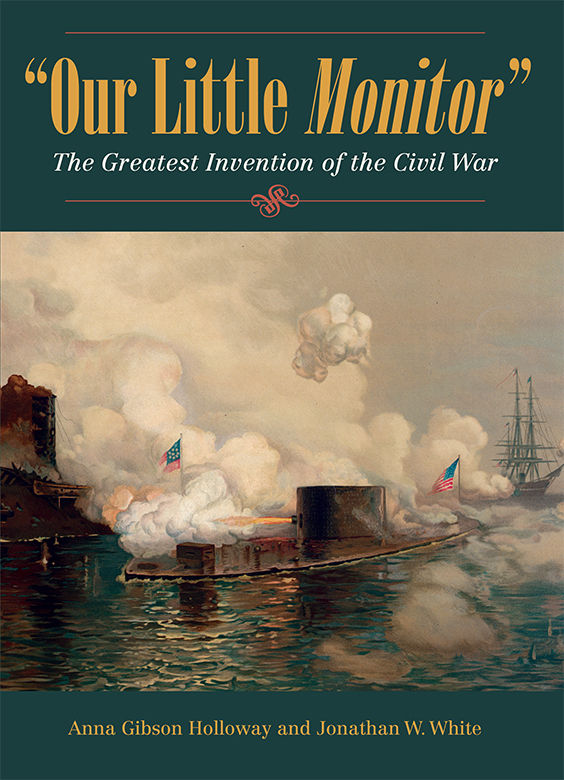Why another Monitor book? In Our Little Monitor, authors Anna Holloway and Jonathan W. White demonstrate that a fascinating subject is never exhausted. Cutting-edge maritime archaeology and thorough historical research combine to produce an engaging narrative with plentiful illustrations, some not previously published. Numerous first-person quotes from various viewpoints ashore and afloat provide perspective.
The book has two parts. Part I opens with a chapter on the origins of Monitor’s opponent, the CSS Virginia (ex USS Merrimack), then narrates Monitor’s story from her inception in the fall of 1861 through her loss at the end of 1862.
Colorful characters emerge in an atmosphere of crisis: the eccentric inventor John Ericsson; ambitious industrial tycoons; crusty old salts of the wood and canvas navy; harassed administrators like Navy Secretary Gideon Welles; brilliant young “scientific officers”; and engineers of the new industrial generation. The political and technological dimensions of the ironclad’s development are well presented.
The middle chapter of Part I is an excellent overview of the Battle of Hampton Roads, waged March 8-9, 1862, in which Virginia destroyed the USS Cumberland and the USS Congress on the first day and pounded Monitor to a draw on the second. Those wishing a more detailed strategic and tactical examination of these engagements will look elsewhere, but nonetheless benefit from this work’s enlightening perspective.
Next comes a unique discourse on the vessel’s impact on nineteenth-century popular culture. “Monitor mania” is a subject not frequently addressed. The little ironclad became the people’s darling, proudly displayed in numerous prints, tokens, and bric-a-brac. She was featured in advertisements for—among other products—playing cards, flour, refrigerators, and reapers. She floated by in many parades.
A discussion of the battle’s aftermath and the frustrating later careers of Monitor and Virginia follows. A few weeks of standoff in Hampton Roads ended when Confederates were forced to abandon Norfolk and her own crew destroyed Virginia. Monitor participated inconclusively in the Battle of Drewy’s Bluff in May 1862, supported General George McClellan’s operations on the Peninsula, and then, with additional repair and refit, departed on the voyage south that doomed her.
The final chapter in Part I describes the long search for and partial recovery of the little ironclad in the late 1990s and early 2000s. This groundbreaking effort—and subsequent research, conservation, and artifact display—is a partnership between the National Oceanic and Atmospheric Administration (NOAA) and the Mariners’ Museum and Park in Newport News, Virginia.
The wreck site is now the Monitor National Marine Sanctuary. The most significant parts were raised, including much of the engine room and the iconic revolving gun turret. Also discovered were nearly 5,000 artifacts, including personal items, bits of clothing, and the remains of crewmen. The artifacts are preserved and can be viewed in the magnificent USS Monitor Center at the Mariners’ Museum and Park. Read the book and then visit the Monitor Center, or vice versa.
Part II of “Our Little Monitor” immerses the reader in the words of the story’s participants with six short chapters reproducing previously unpublished letters and journal entries. These are personal views of real people experiencing epic events.
As former curator of the award-winning USS Monitor Center and a nationally recognized maritime historian, Anna Holloway is, with Jonathan W. White’s able assistance, uniquely qualified to produce this study. With its superior production quality—hefty, glossy paper and crisp illustrations in vibrant color—the book is best enjoyed in hardbound, or at least with a good, large-screen digital device.
Admiral Raphael Semmes, the Confederacy’s foremost sailor, introduced his memoirs with the following: “The cruise of a ship is a biography. The ship becomes a personification. She not only, ‘walks the waters like a thing of life,’ but she speaks in moving accents to those capable of interpreting her.” Semmes was writing of his infamous commerce raider, the CSS Alabama, but Anna Holloway and Jonathan White have similarly interpreted the USS Monitor in an excellent biography.
Dwight Hughes is a retired U.S. Navy surface warfare officer, public historian, author, and speaker on Civil War naval topics (https://civilwarnavyhistory.com/). His second book, Unlike Anything that Ever Floated: The Monitor and Virginia and the Battle of Hampton Roads (Savas Beatie) will be released in spring 2020 as a volume in the Emerging Civil War Series.




